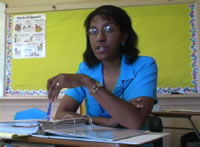|
BE HONEST WITH STUDENTS about why standard English is necessary and why it is the "standard."
Listen to a brief audio clip about being honest with students. (QuickTime plugin required)
|
Be honest with your students. |
(mm:ss) |
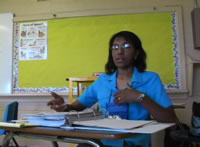 |
| I elaborate on this advice regarding the teaching of grammar, and describe some struggles with the beginning of this particular school year. |
play
|
Quicktime Player
high • low
get plugin |
Windows Media
high • low
get plugin |
|
Grammar Exercise |
(mm:ss) |
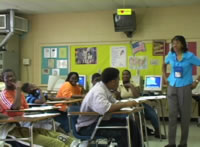 |
Part 1: A grammar exercise from the beginning of the year.
Part 2: I begin a conversation standard English with my students.
Part 3: I reflect briefly on my approach to teaching grammar.
|
play
|
Quicktime Player
high • low
get plugin |
Windows Media
high • low
get plugin |
|
|
|
Take the time to KNOW YOUR STUDENTS; respect them and their culture.
William Ayers in his book, To Teach: The Journey of A Teacher, gives one of the best working definitions of culture and its relationship to teaching and learning:
"Culture is an important window into a child....and effective teachers must learn to be lifelong students of culture....Culture includes all the surface objects and characteristics of a people-things like food, art, clothing, music, crafts, and so on. And culture embraces, as well, all the traditions and customs people create: their rituals, games, sports, dialects, habits, and ways of life. But on the deepest and most subtle level, culture also embodies a people's beliefs and values, their way of looking at the world" (75-76).
Ayers goes on to point out that there is very often a cultural gulf between teacher and students. It is the teacher's professional duty to make some sustained effort to understand and to bridge that gulf. There are many ways to accomplish this: talking with and listening to parents; attending community events; listening to community leaders or veteran teachers; listening to your students. In addition, one can do more formal information gathering through surveys. Like many teachers, I have my students write me a letter of introduction as part of the first days of school.
The critical thing is that students know that we really do want to know about them and care about them as persons.
Ayers, William. To Teach: The Journey of A Teacher. New York: Teachers College Press, 2001.
|
Take time to know your students (1) |
(mm:ss) |
 |
| I discuss getting to know students individually in and out of school, as a group, and in a pedagogical sense. |
play
|
Quicktime Player
high • low
get plugin |
Windows Media
high • low
get plugin |
As one way of getting to know my students early in the year, I ask my students to write a letter to me pretending that ten years have passed since their high school graduation. Typically, I reply to each student. I find this to be a useful way to learn more about each student's interests, hopes, and dreams.
|
Take time to know your students (2) |
(mm:ss) |
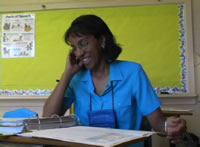 |
"Getting to know students in terms of their performance..." |
play
|
Quicktime Player
high • low
get plugin |
Windows Media
high • low
get plugin |
In this clip, I reflect on understanding student achievement in a time of high-stakes testing. I discuss contradictions between student work and test results, and their implications for my teaching. |
"We do not teach subjects...." I respond to the questions that teacher educators have heard some new teachers ask, such as, "I'm teaching math--why do I need to know my students?" I elaborate on the importance of building relationships with students and discuss specifically why it matters in context of teaching language. |
VIEW STUDENT LETTERS
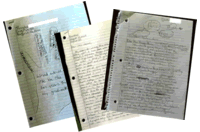
|
Connecting with parents |
(mm:ss) |
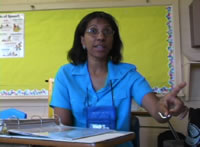 |
I discuss connecting with parents, in particular to neutralize some community members' negative experiences with education. Also: Identifying a significant adult mentor for student support. Creating a sense of ownership. Building trust. |
play
|
Quicktime Player
high • low
get plugin |
Windows Media
high • low
get plugin |
|
"...and get to know the curriculum." |
(mm:ss) |
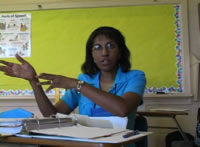 |
I reflect on how tensions between covering the curriculum v. preparing students for standardized testing affect my instruction. Also: the challenges of aligning my curricular plans with the individual needs of each student.
|
play
|
Quicktime Player
high • low
get plugin |
Windows Media
high • low
get plugin |
|
|
|
Grammar instruction should BE FOCUSED; don't try to "cover" or "fix" everything at once.
 KISS Grammar Curriculum: A Summary KISS Grammar Curriculum: A Summary
In my classroom, I have been using a modified version of the KISS Curriculum as part of my grammar instruction. This model was developed by Ed Vavra at the Pennsylvania College of Technology.
I use this method during the first 5-10 minutes of my class everyday to provide direct instruction to the my students in grammar. We also do mini-lessons on specific grammar topics during times when they are drafting writing. When working with students on their writing, I try to avoid "marking" every error I see in grammar or mechanics. Instead, I look for patterns of error, and try to isolate one or two areas for the student to focus on in that particular piece of writing. I have found this approach to be much less frustrating (for students and me) and much more productive in terms of retention and results.
Visit the student work page to learn more about my assessment of student writing.
|
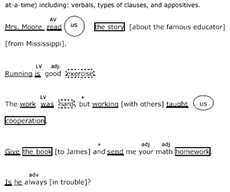
 Examples of the adapted KISS Grammar Curriculum Examples of the adapted KISS Grammar Curriculum
This method helps students learn to identify parts of a sentence sequentially using simple markings. The method also develops retention by using repetition and building on previous steps. |
Don't try to cover or "fix" everything at once. |
(mm:ss) |
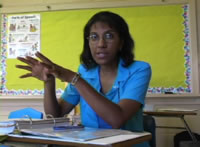 |
I discuss how I focus on a few specific skills at a time when I evaluates writing, to avoid overwhelming myself and my students.
|
play
|
Quicktime Player
high • low
get plugin |
Windows Media
high • low
get plugin |
|
Reflections:
KISS Grammar Model (6) |
(mm:ss) |
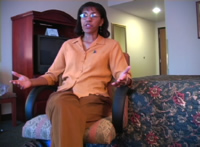 |
"Why did you decide to use this model? What place does it have in your curriculum?"
|
play
|
Quicktime Player
high • low
get plugin |
Windows Media
high • low
get plugin |
|
Reflections:
KISS Grammar Model (7) |
(mm:ss) |
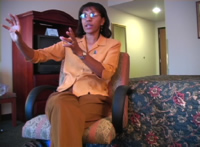 |
"How does grammar fit into the larger context of your curriculum?" [Longer video; may take some time to load.]
|
play
|
Quicktime Player
high • low
get plugin |
Windows Media
high • low
get plugin |
|
Reflections:
KISS Grammar Model (8) |
(mm:ss) |
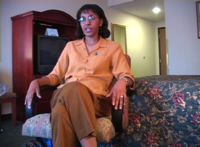 |
"Is your teaching of grammar representative of your teaching in other curricular areas?"
|
play
|
Quicktime Player
high • low
get plugin |
Windows Media
high • low
get plugin |
|
|
|
|
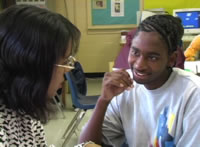 Culturally Engaged Instruction:
Culturally Engaged Instruction: 




